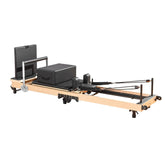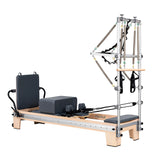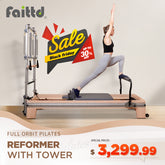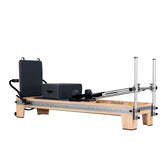What to Eat Before Reformer Pilates: Complete Nutrition Guide
Food and exercise go hand in hand—just like you wouldn't drive your car on an empty tank, you shouldn't do Pilates on an empty stomach. But eating too much or too close to your workout can make you feel uncomfortable on the reformer. From what to eat and when to eat it, to staying hydrated and avoiding common mistakes, we'll cover all the essential nutrition tips to help you feel your best during your next Reformer Pilates session.
Why Nutrition Matters for Pilates Practitioners
Good nutrition is like setting yourself up for success in Pilates. Just as you need a good mat or properly set springs on the Pilates reformers, your body needs the right fuel to make the most of your practice.

Here's why nutrition matters for your Pilates practice:
1. Energy That Lasts
Nobody wants to feel weak or shaky during their hundred exercises! Good nutrition helps you maintain steady energy throughout your session. When you fuel your body right, you'll find it easier to hold those challenging positions and work through your entire class without hitting an energy wall.
2. Better Movement Control
Your muscles need good fuel to work properly. When you're well-nourished, it's easier to control those small, precise movements Pilates is famous for. This is especially important when you're working on the Reformer—you want your muscles to respond exactly when and how you need them to.
3. Staying Sharp and Focused
Ever noticed how hard it is to focus when you're hungry? Eating right helps keep your mind clear so you can follow your instructor's cues and remember those exercise sequences. Plus, when you're not distracted by hunger, you can focus better on your form.
4. Feeling Comfortable
There's nothing worse than feeling too full during roll-ups or having an empty, growling stomach during class. When you time your meals right and eat proper portions, you can move comfortably through all the exercises—even those that put pressure on your stomach.
5. Bouncing Back Better
Good nutrition helps your body recover after class, so you're ready for your next session. This is especially important if you practice regularly—you want to feel energized, not worn out.
Pre-Pilates Nutrition Guidelines
When to Eat Before a Pilates Session

Key Nutrients
| Nutrient Type | Purpose | Recommended Foods |
| Carbohydrates | Energy Source |
|
| Proteins | Recovery Support |
|
| Healthy Fats | Sustained Energy |
|
Pro Tips:
- Keep portions small—about palm-sized for a total snack
- Test new foods on rest days first
- Adjust timing based on your digestion
Hydration Schedule
| Timing | Recommendations |
| Before Practice |
|
| During Practice |
|
| After Practice |
|
Pro Tip: Start hydrating well before your session and maintain steady water intake throughout the day.
3 Common Mistakes to Avoid
Mistake 1: Eating Too Much or Too Little
Finding the right balance with your pre-Pilates meals can be tricky. Too much food leaves you feeling heavy and uncomfortable on the reformer, especially during exercises that involve lying on your stomach or rolling. On the flip side, coming to class on an empty stomach can leave you feeling weak, shaky, and unable to maintain proper form.
Signs you've eaten too much:
- Feeling sluggish during movements
- Experiencing acid reflux or discomfort
- Having difficulty with core engagement
- Feeling nauseous during inverted positions
Signs you haven't eaten enough:
- Light-headedness during exercises
- Shaky muscles
- Difficulty concentrating
- Low energy levels
- Excessive hunger during class
Solution:
Aim for a small meal or snack that fits in the palm of your hand. Choose easily digestible foods that combine carbs and protein, like a banana with a few almonds or half a piece of toast with peanut butter.

Mistake 2: Ignoring Food Timing
Timing your meals around your Reformers Pilates practice is just as important as what you eat. Many people make the mistake of either eating too close to class time or letting too much time pass between their last meal and their workout.
Common timing mistakes:
- Eating a big meal 30 minutes before class
- Showing up to morning class without breakfast
- Having sugary snacks right before practice
- Skipping meals earlier in the day
Solution:
- 2-3 hours before: OK to eat a regular meal
- 1 hour before: Stick to a light snack
- Less than 30 minutes before: Best to skip eating
- For morning classes: Have a small snack 30-45 minutes before if you can't manage breakfast
Mistake 3: Eating the Wrong Foods Before Reformer
For the most comfortable and effective Reformer Pilates session, avoid these foods 2-3 hours before class and try the suggested alternatives instead.
| Food Category | Foods to Avoid | Better Choices |
| Heavy & Fatty Foods |
|
Grilled lean proteins, light dressings, low-fat dairy |
| Gas-Forming Foods |
|
Steamed vegetables, well-cooked grains, still water |
| High-Sugar Items |
|
Fresh fruit, whole grain toast, natural energy foods |
| Spicy Foods |
|
Mildly seasoned foods, fresh herbs for flavor |
| Heavy Proteins |
|
Small portions of lean protein, light protein snacks |
Save these foods for after your Pilates session when you can enjoy them without affecting your practice.
Plan Your Pre-Pilates Meals
Good nutrition directly enhances your performance in Pilates. Timing is simple: have a light meal 2-3 hours before class, or take a snack 30 minutes before your reformer session. Steer clear of heavy, spicy, or greasy foods that can make you uncomfortable during exercise; drink water throughout your day. By finding a pattern of eating that works for you, you will notice your strength improving, your focus at a better level, and your control over challenging exercises greatly enhanced.
Pilates Nutrition: Your Most-Asked Questions Answered
Q1: Can I do Pilates on an empty stomach?
No. Eat a small snack 30 minutes before Reformer Pilates session to fuel your movements and maintain muscle control.
Q2: How long should I wait before doing Pilates after eating?
For a full meal, wait 2-3 hours. For a light snack, 30-60 minutes is usually enough. This gives your body time to digest and helps prevent discomfort during exercises.
Q3: I get shaky during class—is this related to what I eat?
Yes, shakiness is often a sign of low blood sugar. This usually happens when you haven't eaten enough before class or waited too long between meals. A small snack 30-60 minutes before class can help prevent this.
Q4: Is it okay to have coffee before Pilates?
Yes, but drink it at least 1 hour before class to avoid jitters and stomach discomfort.
Q5: I have an evening class—should I eat dinner before or after?
Have a light snack before class and save your full dinner for after. If you're hungry, eat a small portion of easily digestible food 1-2 hours before class, then have your main meal after practice.





